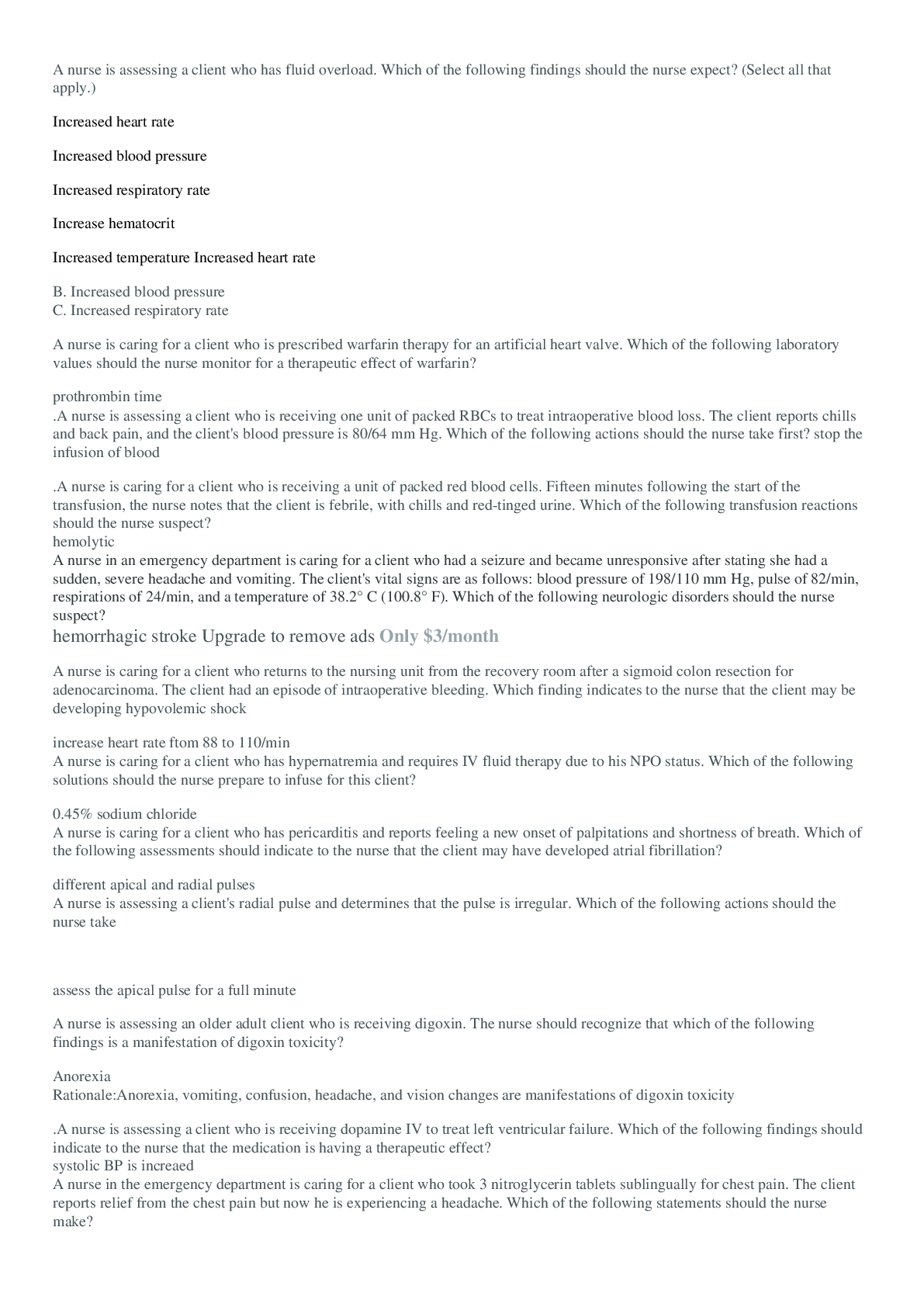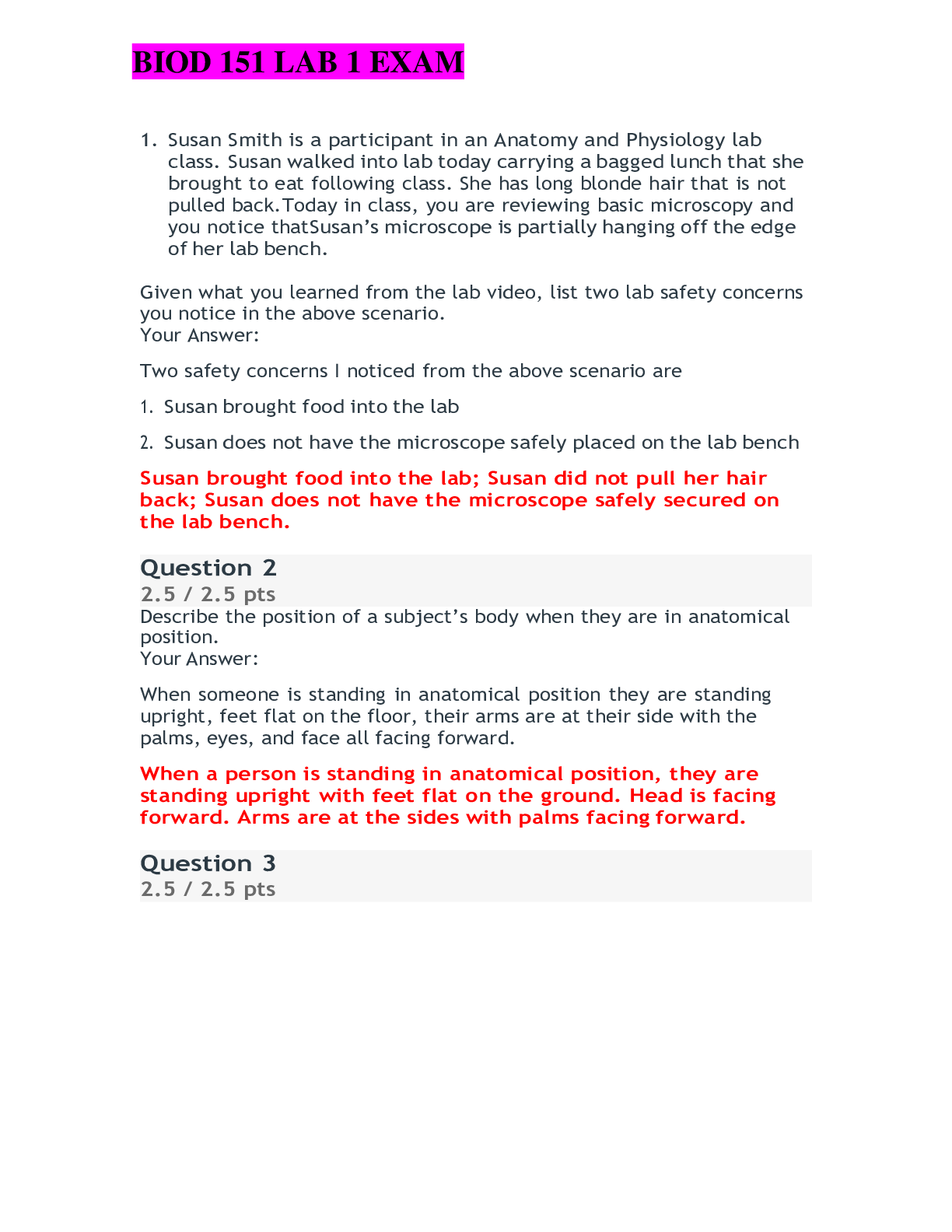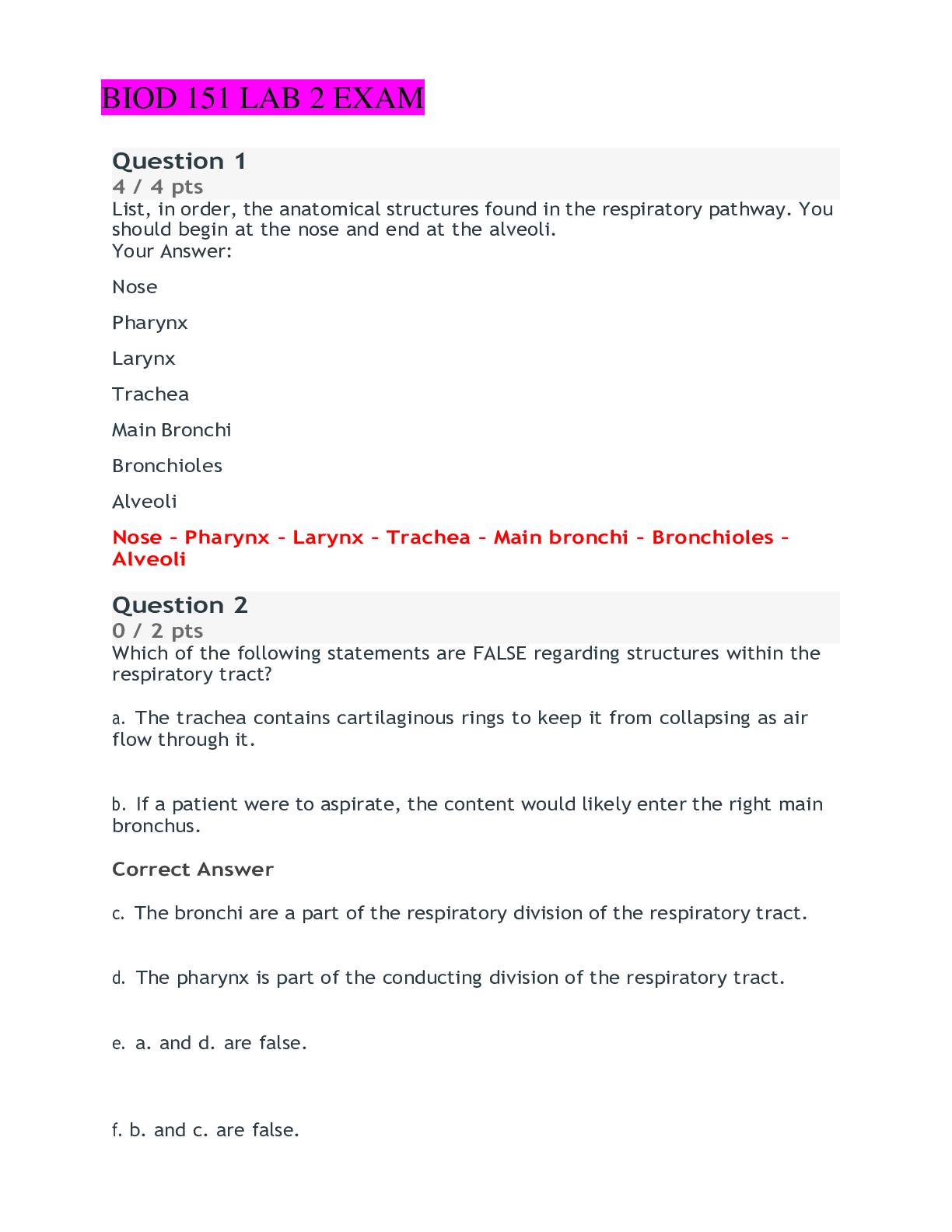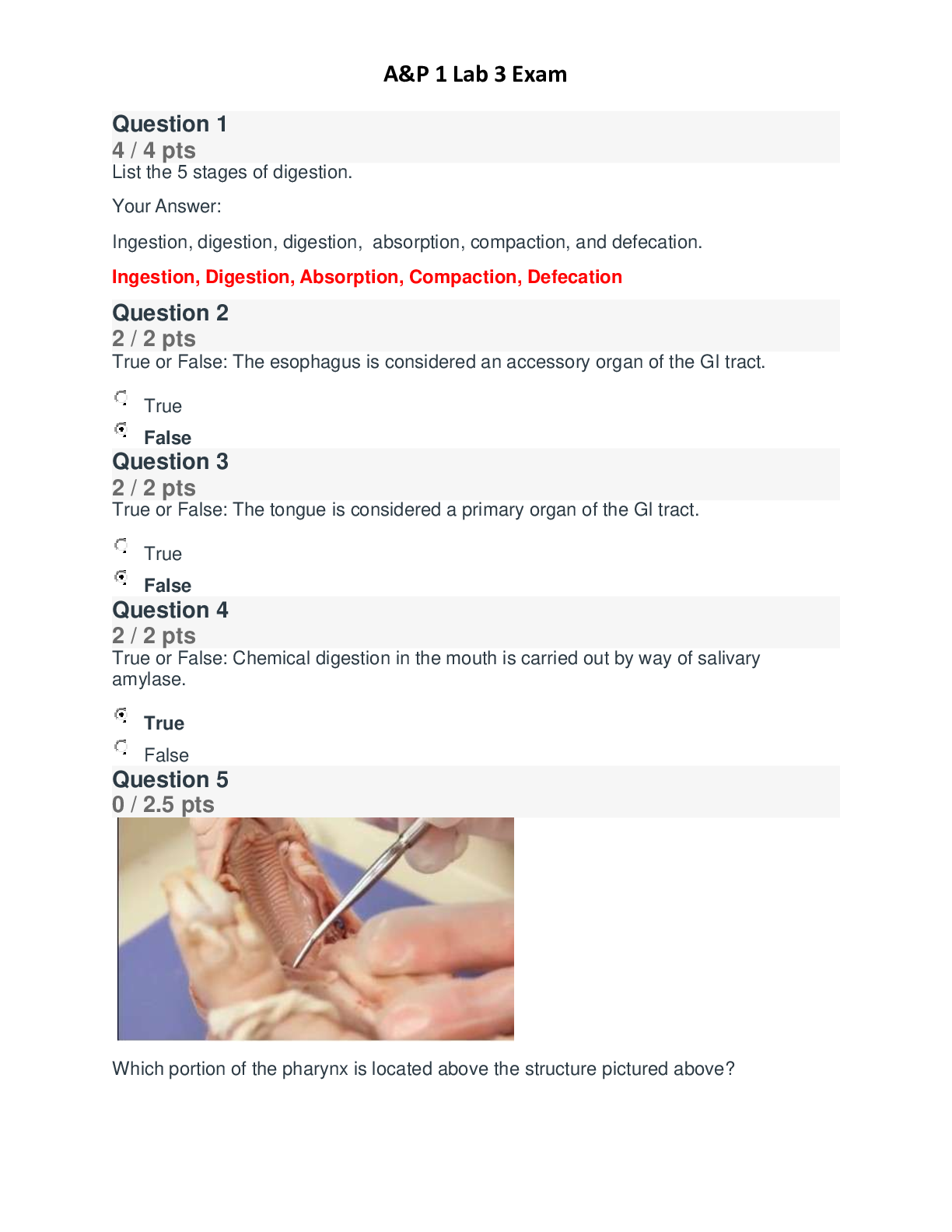Education > QUESTIONS & ANSWERS > ATI TEAS 6: Reading Questions and Answers Rated A+ (All)
ATI TEAS 6: Reading Questions and Answers Rated A+
Document Content and Description Below
ATI TEAS 6: Reading Questions and Answers Rated A+ Main Idea ✔✔-what the author wants to say about the topic i.e. ask yourself how the author feels about that topic NOTE: most of the time fict... ion will have a theme, and nonfiction will have a main idea Topic ✔✔-overall subject matter of the passage i.e. ask yourself what you're reading about Theme ✔✔-generally a true idea that the reader might derive from a text To build an outline of the text ✔✔jot down words and phrases as you read that describe the main idea and underline the important details Topic Sentence ✔✔-makes a general statement usually supported by details later -generally the first sentence or very near Persuasive Passage ✔✔-supporting details: may use specific facts and data, or it may detail specific reasons for the author's opinion Informative Passage ✔✔-will primarily use facts about the topic to support the main idea Narrative Passage ✔✔-will have supporting details--the specific things the author says to develop the story and the characters Signal words or Transitions or Conjuctions ✔✔-adds information, provides counterarguments, create organization, or draw conclusion i.e. in particular, in addition, besides, in contrast, therefore, because, or many other similar phrases NOTE: these signal words indicate how an unfamiliar word is related to the overall meaning of the sentence or passage NOTE: To distinguish between a fact and opinion ✔✔ask is a statement can be proven. -look for subjectivity by asking if an observation could vary according to the situation or person observing -opinion = narrator's views Cause and Effect ✔✔the author describes a situation and then its effects Compare and Contrast ✔✔the author explores the similarities and differences between two or more things Problem and Solution ✔✔the author presents a problem and offers a solution Descriptive ✔✔the author describes a topic Chronological ✔✔the author lists events in the order in which they happened NOTE: Repetition ✔✔Authors often use repetition to reinforce an idea. PAY ATTENTION to any repeated words, phrases or images -then ask why the author might have repeated them NOTE: Considering a character's motivation ✔✔-what does the character want to achieve? -what will the character get by accomplishing this? -what does the character seem to value the most? Purpose: Narrative Passage ✔✔the author tells the reader a story often to illustrate a theme or idea the reader needs to consider Purpose: Expository Passage ✔✔the author explains an idea or topic to the reader -fair and balanced representation of a topic -the author intends mainly to present the details or ideas to the reader to make a decision Purpose: Technical Passage ✔✔explain specific processes, techniques, or equipment in order for the reader to use that process or equipment to obtain the desired result -LOOK FOR: chronological or spatial organization (being able to create images from an author's words), specialized vocabulary, imperative or directive structures Purpose: Persuasive Passage ✔✔the author tries to convince the reader to accept an opinion or belief NOTE: make sure you are aware of what the author believes about the topic Persuasive Writing Techniques ✔✔RHETORICAL STRATEGIES: -assists the author in building an argument -Ethos: an author might explain their credentials or offer concessions to an opposing argument to create a trusted relationship with the reader -Logos -Pathos: appeal to emotion Determine the Audience ✔✔look at the main idea/theme: -who is most likely to care about that idea, benefit from it, or need to know about the topic? -if the text is persuasive who is the author trying to persuade? -if it is explanatory, who would benefit from having this knowledge? look at the language: -Formal = academics or people in a professional setting -Informal = media like commercials NOTE: Connotation of a Word ✔✔-ask if the word conveys a positive or a negative association in your mind -adjectives are often used to influence the feelings of the reader, like "an ambitious attempt to achieve..." -i.e. dog and canine have a NEUTRAL CONNOTATION pet and puppy have a POSITIVE CONNOTATION cur and mutt have a NEGATIVE CONNOTATION Mood ✔✔-pervasive (prevalent) feeling or atmosphere in a passage that provokes specific emotions in the reader -influences a reader's emotional state in the piece Tone ✔✔-describes the author's attitude toward the topic -establishes the relationship between the audience and the author Context Clues ✔✔-sometimes authors may use a difficult word, then say "that is" or "which is" to signal the reader that they are providing a definition OR -the authors may restate the idea in familiar words -i.e. Teachers often prefer teaching students with INTRINSIC motivation; these students have an INTERNAL desire to learn. -The meaning of intrinsic is restated as internal Figures of Speech ✔✔-engage a reader's imagination and add emphasis to different aspects of their subject Metaphor ✔✔-an analogy -explaining something unfamiliar with something familiar -i.e. If a person refers to a problem as an "elephant in the room" ELEPHANT works as how big the problem is Simile ✔✔-directly points to similarities between two things NOTE: Simile uses "like" or "as", but metaphor does not Forms of Sources ✔✔Sources may answer specific questions posed in a text, enrich the information provided on a topic by the writer, or support a writer's argument -written documents -audio-visual materials -information found over the Internet -in-person interviews Evaluating Sources ✔✔-education -firsthand experiences -motivation of the author: indicate bias -author's background and expertise -place of publication: academic journals and established newspapers are more reliable unlike blogs and websites Evaluating Website ✔✔-intended audience -agenda for selling or promoting something Questions to Consider ✔✔1. Is the source current? 2. If it is a secondary source, is it based on both primary as well as other secondary sources? 3. Is the author an expert in the area of study? Does he or she cite relevant information from other authorities on the topic? 4. Is the author's purpose clear? That is, is there any apparent bias? 5. What does the author assume is true? 6. Does the author present multiple viewpoints? 7. Does the content align with other reliable sources on the topic? Primary Sources ✔✔-used if researcher's purpose is to analyze, interpret, or critique a historical event, a creative work, or a natural phenomenon -firsthand experience: letters, emails, autobiographies, diaries, memoris, eyewitness, interviews, questioneers, photographs Secondary Sources ✔✔-written analysis or interpretation of a primary source -no firsthand experience -examine primary sources to draw conclusions or make generalizations about people, events, or ideas -i.e. literary criticism, political analysis, biographies, essays on ethics and social policies Maps ✔✔-meanings of symbols shown in the LEGEND -SCALE: spatial relationship between the features on a map indicated by their position -COMPASS Axis Label ✔✔shows the units of data being displayed in a graph Blood Pressure Monitor ✔✔-Systolic mmHg (upper #) Normal = 120 -Diastolic mmHg (lower #) Normal = 80 -Heart rateF Looking at a Flyer or Advertisement ✔✔Look for: -author -intended audience -rhetorical strategies designed to influence the viewer May use bold, italics, or underlined text Following Directions ✔✔-First, identify the initial conditions laid out by the problem: this might be a spatial relationships between figures or certain number of items (i.e. three red marbles and two green marbles) -Look for markers that indicate sequence (i.e. first, next, then, finally -Relationship between the steps: action carried out in #1 effects #2, make sure each act is completed NOTE: ALWAYS write down the result of each step [Show More]
Last updated: 1 year ago
Preview 1 out of 7 pages
.png)
Buy this document to get the full access instantly
Instant Download Access after purchase
Add to cartInstant download
We Accept:

Also available in bundle (1)

ATI TEAS BUNDLED EXAMS QUESTIONS AND ANSWERS LATEST 2022 WITH COMPLETE SOLUTIONS
ATI TEAS BUNDLED EXAMS QUESTIONS AND ANSWERS LATEST 2022 WITH COMPLETE SOLUTIONS
By Nutmegs 1 year ago
$50
49
Reviews( 0 )
$7.00
Document information
Connected school, study & course
About the document
Uploaded On
Sep 19, 2022
Number of pages
7
Written in
Additional information
This document has been written for:
Uploaded
Sep 19, 2022
Downloads
0
Views
83

.png)
.png)
.png)
.png)
.png)
.png)
.png)
.png)
.png)
.png)
.png)

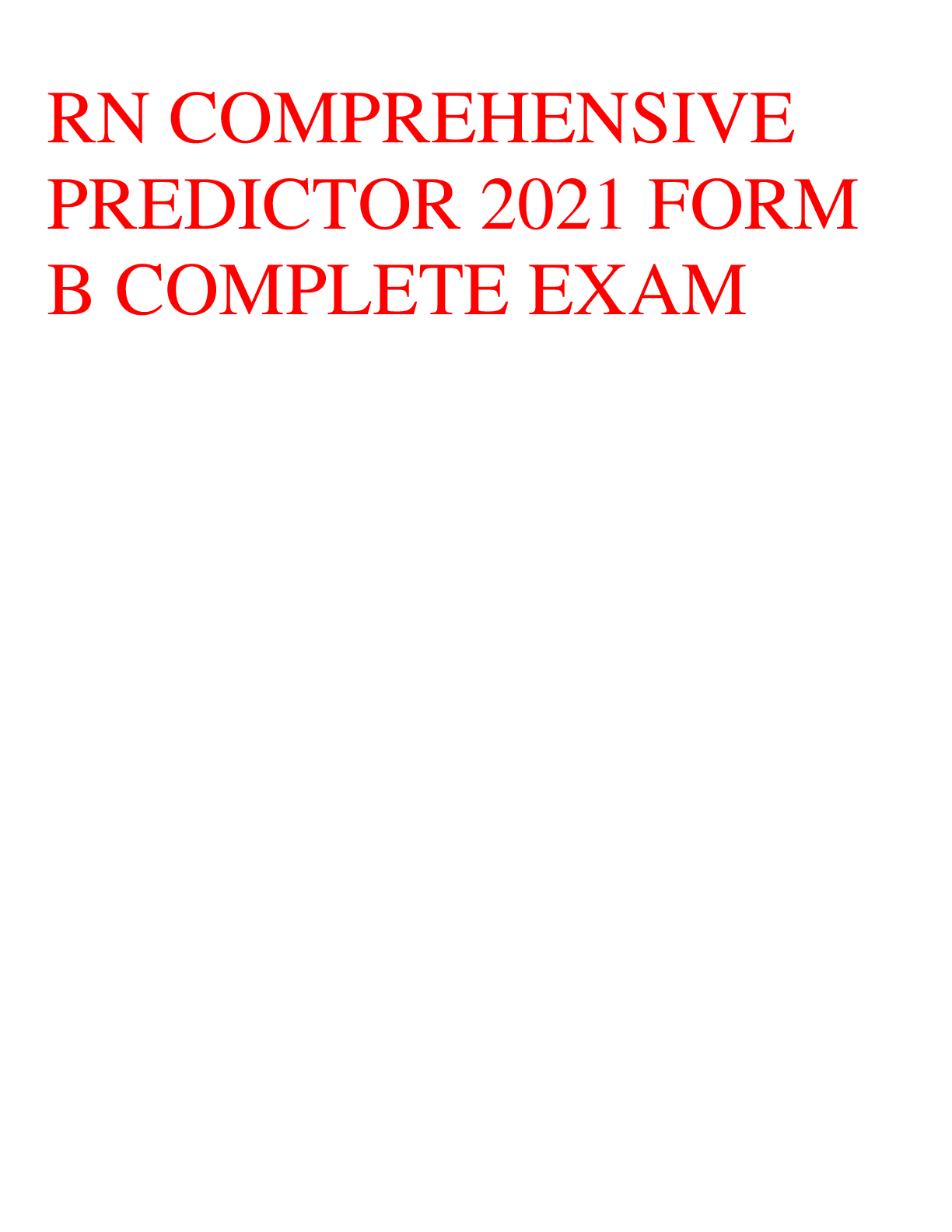

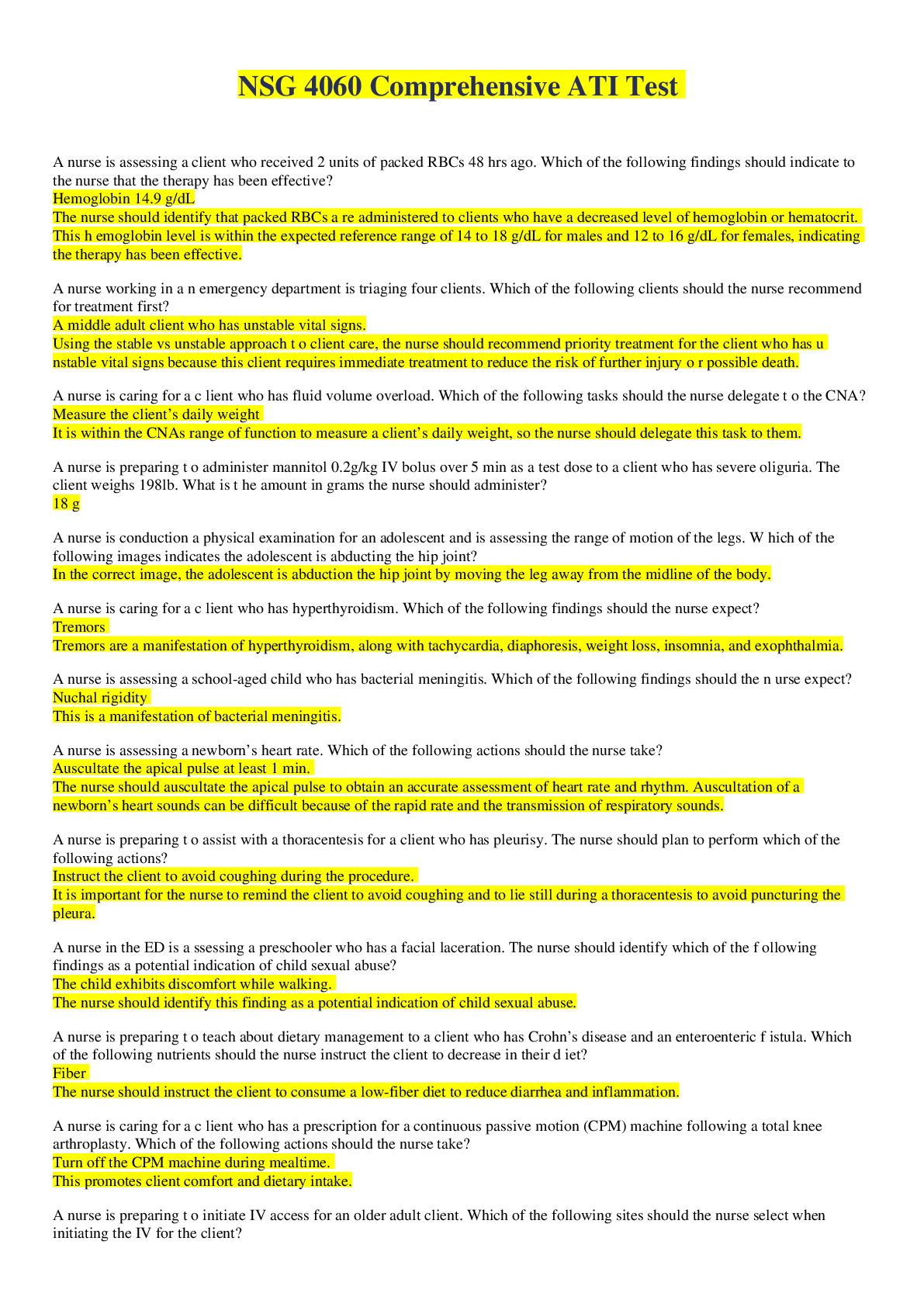

.png)
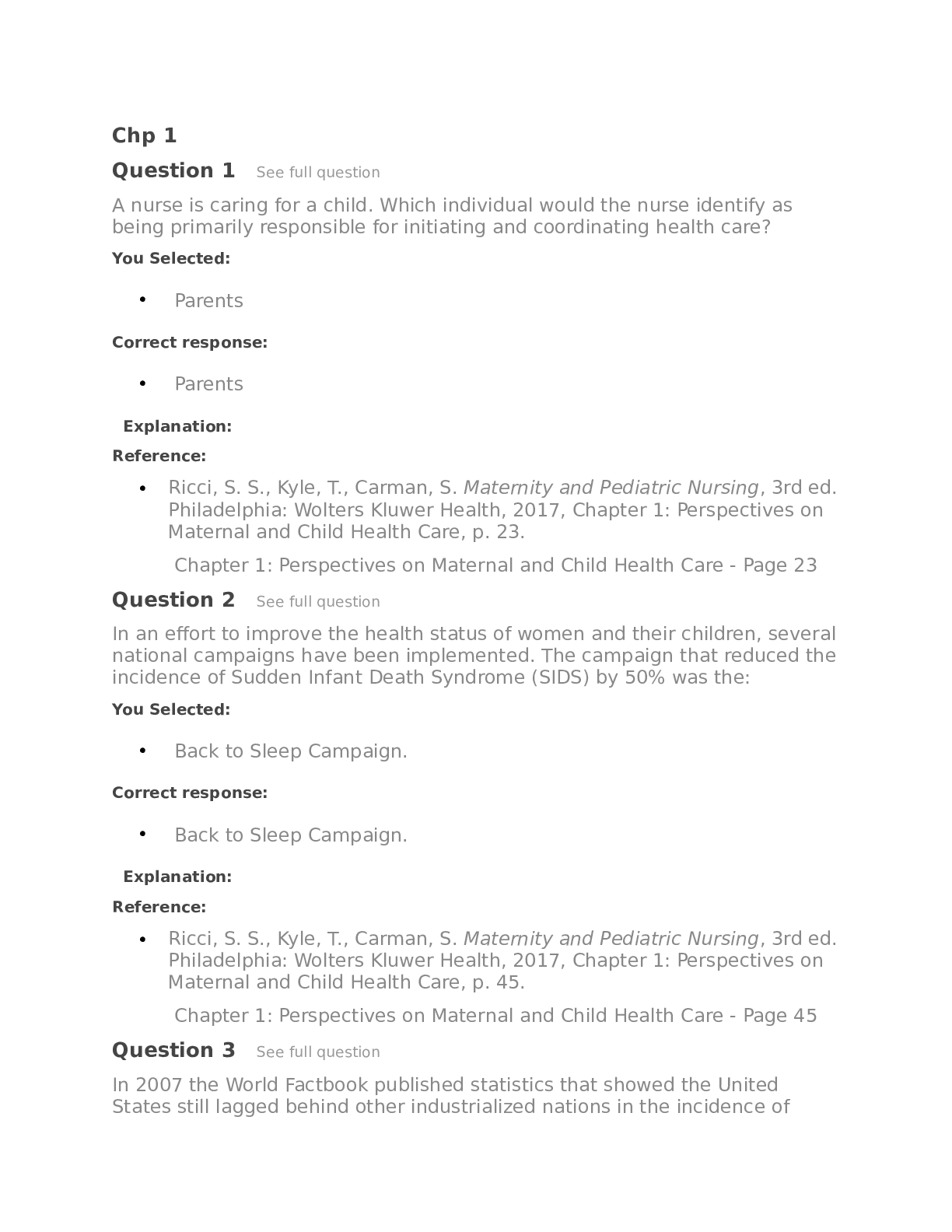

.png)
